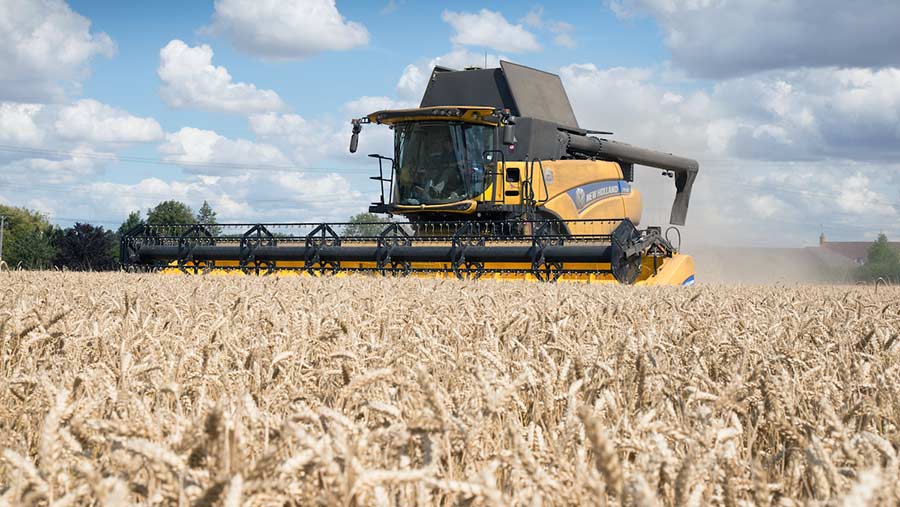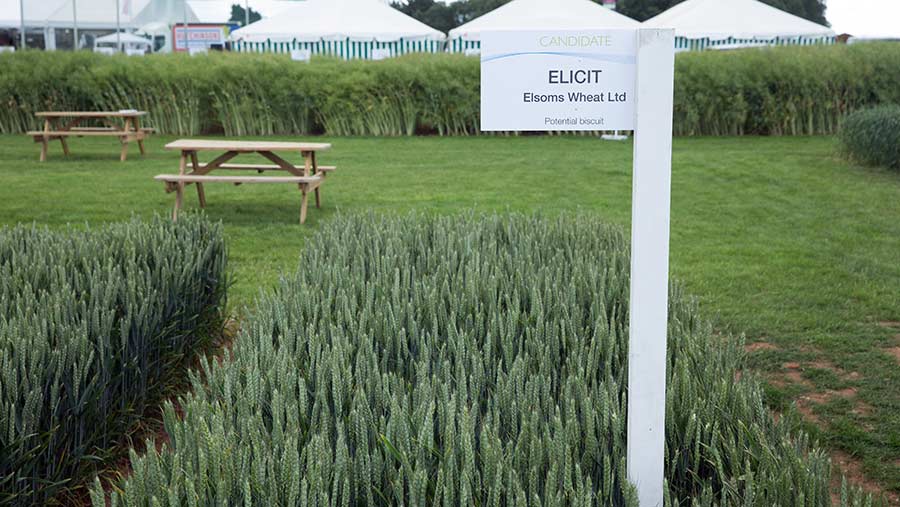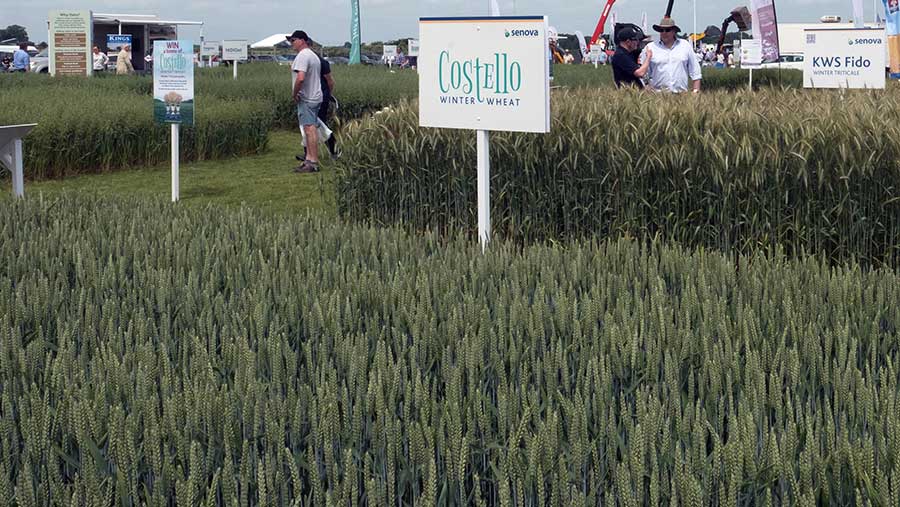Why biscuit wheats could trump milling varieties this autumn
 © Tim Scrivener
© Tim Scrivener In stark contrast to the Group 1 sector, there aren’t enough Group 3 wheats being grown in the UK to meet demand and the millers are keen to secure supplies.
As a result, the premiums on offer for biscuit-making wheats are more attractive than those for the Group 1s, prompting renewed interest in a market sector that has shrunk to just 6% in recent years.
While there were no new Group 3 variety additions to the Recommended List this year, there is activity around two of last year’s introductions, Barrel and Basset, both of which are expected to sell out.
See also: Distorted milling wheat market puts agronomics in spotlight
Biscuit use
Most importantly, they have the required grain quality, with millers stressing that they are looking for Group 3s, rather than soft Group 4s, if the end use is biscuits.
“Requirements differ between end users and there is more flexibility with soft wheats being used for batters and coatings than there is for those going into biscuits,” explains Howard Leland, procurement director with Allied Mills.
“At Allied, our requirement is for Group 3s only for biscuits. Some of the soft Group 4s don’t suit that purpose, so we can’t use them.”
Another consideration is millers can’t import supplies of biscuit-making wheat to make up any shortfall, as its production is unique to the UK – representing a niche marketing opportunity for dedicated growers.
Limited choice
Group 3 wheat varieties
- Firm favourites Zulu
- Rising stars Barrel, Basset and Elicit (candidate)
At first glance, the choice of Group 3 varieties seems healthy. But seed availability and susceptibility to new yellow rust races are narrowing the options, point out the seed trade, which urges growers to commit quickly if they have a strong variety preference.
“There are six recommended Group 3 varieties, and of those it’s fair to say Claire has done its job now,” says Lee Bennett, Openfield’s national seeds manager.
“It’s becoming difficult to grow. There’s very little seed, just enough for the diehards.”
Otherwise, Britannia has succumbed to yellow rust and Spyder seed is also in very short supply, he adds.
“That leaves us with three varieties. Zulu was hammered by yellow rust last year but the end users like it, especially in the North. Its suitability for distilling means that Zulu will be the biggest variety in Scotland.”
Barrel and Basset
South of the border, the Group 3 market will be divided between Barrel and Basset, predicts Mr Bennett. “They have the most seed available and will sell out.
“They are both stiff strawed, have very good yellow rust score and bring resistance to orange wheat blossom midge.”
Barrel offers the highest yield at 103% of control, but has a disappointing 4.4 for septoria on a scale where 1 is very poor and 9 is very good disease resistance.
Basset, on 100% for yield, is shy to tiller and needs a higher seed rate, reflecting its Scout parentage.
“Neither of these two are suitable for distilling, so the marketing options are clear. They are good for export and for biscuits.”
David Bouch, seed manager at Hutchinsons agrees that there is more excitement in soft wheat this year than there has been for some time.
Seed warning
“The irony is that the opportunity for soft wheat is there without huge availability of seed. The better varieties will sell out very soon.”
He agrees Barrel has the double advantage of high yields and a potentially useful premium, but considers it less suitable for regions where septoria pressure is very high.

© Tim Scrivener
He also highlights the candidate winter wheat variety Elicit from Elsoms, which is up for recommendation later this year.
“It’s good to see new biscuit-making varieties coming through the system. Elicit looks to be high yielding, with a good disease resistance package, so hopefully, the millers will give it the thumbs up once testing is completed.”
Soft Group 4s
Some of the soft Group 4 wheats are likely to earn growers a premium this year, predicts Mr Bennett.
With so little Group 3 seed available, there’s a better chance of extra money with some of the soft feed varieties, although it’s difficult to name them at this stage, he cautions.
That sentiment is echoed by Peter Jones, wheat director at miller Rank Hovis, who is pleased to see more choice in the soft feed wheat category, as the company buys soft wheat for its production of flour for coatings and batters which go to a variety of customers.
Soft Group 4 wheat varieties
- Firm favourites Leeds and Revelation
- Rising stars Sundance, Bennington and Motown
“What we buy does depend on our customers’ needs,” he confirms. “But it’s good to see more soft wheats coming onto the Recommended List, as it’s a sector in need of a boost.”
Industry figures show soft wheats have declined from a 53% market share in 2002 down to just 18% in the ground for harvest 2017.
There were six high-yielding additions to the list in this market sector, making it difficult for them all to establish a place in the market, regardless of their attributes.
Again, seed of many of them is in short supply, so growers are being advised to act promptly if they have a particular favourite.
Sundance
Of the newcomers, Sundance is attracting the most attention and being described as a good introduction by the seed trade, despite a tendency to give lower specific weights.
“Sundance is universally appealing,” confirms Mr Bennett. “It has yield, second-wheat performance, blossom midge resistance and the best septoria score on the list. It also gets a medium rating for distilling.”
Mr Bouch is of much the same opinion on Sundance. “There’s a definite place for it. It also has a high untreated yield, so it’s a variety that should be fairly easy to grow.”
The other newcomers include very high yielding Bennington and early to mature Motown, as well as two contenders for the North, Savello and Hardwicke, and another UK choice, Moulton.
Many of these are tall, with slightly weaker straw than existing choices, warn agronomists, who urge caution and recommend that growers take a close look at their resistance to lodging scores before ordering their seed.
Motown
Growers who have had success with Revelation up until now should take a look at Motown, suggests Mr Bennett, as it brings an extra 5% yield and is very early to mature.
“We expect to see good uptake of Motown,” he says. “It’s the obvious successor for Revelation, with some better agronomic characteristics including blossom midge resistance.”
Russell Frost, seed manager at Cofco believes Bennington will be of interest to growers in East Anglia.
“It’s the highest yielding soft wheat on the list, it has good standing ability and some solid disease resistance scores. It’s also suitable for export.”
Bennington
Colin Lloyd, head of agronomy at Agrii likes the look of Bennington for lighter land and predicts it will find a niche.
He notes growers are ready to move on from Leeds and Revelation now, so will be taking a closer look at the alternatives.
“There’s huge interest in varieties that yield. And the new additions do offer that – in some cases as much as 6% more.
“Otherwise they will have to pick and mix – deciding which attributes are important to them. Straw strength is a concern in many of the new varieties.”
Hard Group 4s
Soft Group 4 wheat varieties
- Firm favourites Graham, Diego, Evolution and Costello
- Rising stars Kerrin, Shabras and Dunston
Four of the predicted top-selling varieties for 2017-18 are hard Group 4s, reflecting the farmer support for this sector and their loyalty to reliable performers.
Most commentators agree the new additions to the Recommended List will need to work hard to replace some established names and convince growers that it’s time to move on.
“Growers want varieties with stiff straw, nice grain and consistent results from their variety choices,” points out Mr Lloyd. “Matching up the new additions to those criteria isn’t as straightforward as it should be.”
Kerrin
Top of the Recommended List is newcomer Kerrin, with an East and West region recommendation, a yield of 106% and orange wheat blossom midge resistance.
With plenty of seed available for this autumn, it is a Santiago-cross and similar in many ways, claims breeder KWS.
It does, however, have a very low Hagberg – something that shouldn’t matter in a feed wheat, but may explain why it didn’t get a UK recommendation, despite best performance in the North.
Just behind it is another new name, Shabras, also on 106%, but with earlier maturity and good disease resistance ratings, with the notable exception of brown rust.
Shabras and Dunston
Both will be in demand, predicts Mr Frost, who sees a place for Shabras on lighter soils and has already taken orders for Kerrin. He also believes Dunston will appeal, as it is short and stiff and suitable for early sowing.
Mr Lloyd agrees about Dunston. “It’s got nice grain, a 6.7 for Septoria tritici and has done well in second wheat trials.”
Mr Bennett likes the look of Shabras, highlighting its earliness, yield, second wheat strength and good septoria and yellow rust ratings.
“It is a quick developer and puts leaf on quickly, so covers the ground rapidly,” he says. “It’s weakness is brown rust, and growers shouldn’t test its straw strength too much.”
Graham and Costello
Other hard feed varieties expected by the trade to sell well are Graham and Costello. While there isn’t a new Diego for growers to move on to, especially where second wheat performance is required, both of these will do a good job.
“Costello is a banker variety,” says Mr Bennett. “It’s reliable, come what may. Just don’t expect it to make you famous in the pub.”

© Tim Scrivener
Graham will be more popular this year, predicts Mr Bouch, as it has the good standing ability that is missing in some of the newer varieties.
Despite being beaten on yield and disease now, both Evolution and Diego are expected to remain in the mix.
“We won’t see new uptake of these varieties, but they have done well for growers and will continue to be grown. In the same way, Grafton will hang on, as it has an early drilling slot.”
Mr Lloyd simplifies the situation, suggesting that growers “grow Graham as your first wheat, Dunston as your second wheat and Costello as your all-rounder.”

Newark grower John Miller
Case Study: John Miller, Nottinghamshire
Hard Group 4 varieties make up the majority of the winter wheat grown by John Miller, host of the AHDB’s Newark Monitor Farm.
His decision to grow both Skyfall and Siskin last year was a departure from his standard practice, even though they were primarily being grown for yield rather the premiums.
“We did what many growers were tempted to do and tried to get the best of both worlds, by including some quality varieties. The yield gap appears to be insignificant, so it was a gamble worth taking.”
However, Skyfall is being dropped for 2017-18, he reveals. “It didn’t yield as well as we hoped and there aren’t any premiums to speak of, so we are going back to what we do best.”
Siskin will remain in the line-up. “I know it’s a Group 2 but we will be pushing it for yield, not added value. It has stayed clean this year, which is good news.”
Otherwise, he will continue with Evolution, which has done well on the farm, and will try some Shabras as the new introduction.
With 175ha of winter wheat, Mr Miller aims to change his feed wheats about every three years. “We look for good disease resistance and standing ability, as well as yield.”

